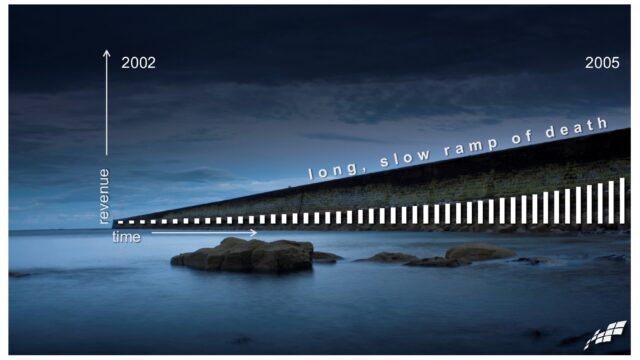Too often, startup founders spend time hoping for a miracle. We want some kind of free, viral, network effect – a silver bullet, so to speak – to suddenly ‘flip the switch’ and skyrocket our software company to profitability.
But that’s not the reality for most software entrepreneurs. That kind of success takes work; there are no silver bullets.
This creeping progression is what Gail Goodman, former CEO of Constant Contact, refers to as ‘the long, slow SaaS ramp of death’.

Table of Contents
Mistaking Mirages for Miracles
Mirage 2: Product Changes and Updates
Mirage 3: Free Trials or Product Tiers
All in all, there are no silver bullets.
How to Make Your Funnel Work for You
The Top of the Funnel: How will prospects learn about you, and how will you reach them?
The Bottom of the Funnel: How will you drive retention and referrals?
Is the long, slow SaaS ramp of death worth the pursuit?
Over time, as turning a profit seems to take longer and longer, founders start asking themselves valid questions like, ‘Are we going to make it?’ and ‘What am I going to need to do to get to that next level, and how do I grow?’
Goodman argues that the answer lies in focusing on two major factors – customer feedback and positive metrics. But the path to those factors is littered with obstacles.
In her 2012 BoS Talk, ‘How to negotiate the Long, Slow, SaaS Ramp of Death’, Goodman lays out the most common hurdles software founders face and how to overcome them.
For a full version of this talk, including a video recording and transcript, click here.
Mistaking Mirages for Miracles
Goodman argues that many founders make the mistake of getting sidetracked by what she calls ‘mirages’ – things that seem to be the answer to meteoric success. At their core, these are the hangups that many founders hope will reshape that long ramp to success into a hockey stick-shaped incline.

While there’s no shortage of these optical illusions, they often take 3 major forms.
Mirage 1: Partnerships
When your company is new and unknown, one of the simplest ways to spread the word about your product or service is to partner with adjacent companies and ride on their backs to gain more brand recognition. After all, partners likely have potentially thousands of customers already that fit your vertical demographic. Plus, they likely have a marketing budget that can blow yours out of the water.
While this looks like a winning strategy on paper, it often isn’t as helpful as it might appear. Why? Because partners aren’t interested in selling a different product; they’re focused on continuing to sell their own. And not only are they less interested in giving some unknown startup a boost, they don’t know how to sell that product effectively.
With every new partnership, you learn a little more about what to do differently the next time. It’s hard work to make these kinds of agreements work, and you’ll likely find your team are the best suited people for actually selling what you offer.
Mirage 2: Product Changes and Updates
Customer engagement matters, and making sure you provide your customers with a ‘wow’ experience – something that blows them away from the start – is vital to your long-term success. From the earliest days of selling your service, getting your users to engage quickly and knowing where they get stuck is essential.
The problem is that as part of this process, too many software companies focus on trying to find the next big product change or update. They continue to believe they’re just one product change from the next inflection point.
But the key isn’t more updates and better interfaces. Your customers must be invested from the first moment they use your product. There is no single change that will make all the difference.
Mirage 3: Free Trials or Product Tiers
Providing a free option is a great way to get new customers and tire-kickers in the door. But like product changes and updates, it often isn’t the big ‘thing’ that makes a huge difference in profit or scalability.
By all means, offer trial runs with no obligation or even a ‘freemium’ option in your pricing tier. In the earliest days of your business, this is a great way to build credibility and trust with consumers. But keep in mind it may not be a viable option forever.
Free trials and ‘freemium’ pricing tiers can mean burning through cash faster than it’s coming in, spelling trouble in the long run, and no-cost options for customers may do little or nothing to help you grow your brand and expand your paying customer base.
All in all, there are no silver bullets.
As a general rule, there is no one thing that will flip your trajectory toward profitability from the ‘long, slow ramp of death’ to the ‘hockey stick inflection curve’.
The only way to make steady gains that result in that flip is to focus on your customer funnel.
How to Make Your Funnel Work for You
It’s easy to get tripped up by the mirages along the path to business growth. But the solution is never just one miraculous thing – it’s lots of little touchpoints along your customer funnel. According to Goodman, ‘Most of those little things will happen if you continue to view your business from your customer or user inward, rather than from the metrics you want to change outward’.
Funnels, at their core, are based on your internal metrics. And the key to changing those internal metrics is to start with the view from your customers looking at your business and their experience, not by looking at your metrics and trying to change your customer behaviour.
Let’s look at the 3 major points in a funnel and the major questions your team needs to answer at each stage along the pipeline.
The Top of the Funnel: How will prospects learn about you, and how will you reach them?
Once you have a minimum viable product, you start to build your funnel. But the most important question is how people will learn about you.
Like many software companies, Constant Contact started with classic, online inbound marketing strategies. They invested heavily in making sure they could be found, optimising their landing pages, researching keywords and buying ads, and writing content. As a result, the business saw a lot of success: They weren’t yet profitable, but getting closer to breaking even. Over time, however, those tactics started to plateau.
Instead of continuing to pour resources into strategies that were dropping off, the team began making a concerted effort to discover why customers weren’t flocking to their doorstep. They started experimenting with offline marketing techniques – regional radio, direct mail, events, and even cold calling.
While some strategies were more successful than others (radio being a surprising one!), there was still no perfect answer that brought the masses pouring in. That led the team to investigate the next stage in their funnel.
The Middle of the Funnel: How does prospect and customer engagement lead to customer value and conversion?
Part of that all-important research to learn why more customers aren’t rushing your doors is finding a way to mix technology and human interaction.
For Constant Contact in the early 2000s, this turned out to be educating small businesses on why they needed email marketing in the first place. As Goodman explained in her talk, ‘The chef running a restaurant wasn’t absorbed in internet marketing. They weren’t even online learning about it. We were going to have to actually get offline to reach them’.
The more human interaction you can add to your early customer touch points, the more likely you are to present potential buyers with a ‘wow’ experience. This could take shape in a number of different forms, such as actual cold calling, calling new customers or trial sign-ups on the phone, or offering free workshops or seminars in person or online.
The Bottom of the Funnel: How will you drive retention and referrals?
It’s not rocket science:Once customers reach the end of your funnel, the best way to get them to stay long-term is to help them find early success. Once you get them to convert, you also get them to stick around.
Ultimately, this juncture in the funnel is all about testing, scaling, and tuning. When customers finally buy from you, do you know what drove them to take that step? It’s all about testing, measuring, and repeating what works or discontinuing what doesn’t.
Look at your funnel from a holistic perspective and be prepared to innovate and pivot. Innovation should be guided by your customers’ experience and how they view your business. The key to a working funnel is knowing how your customers will learn about your business and why they need your product, and then understanding when in the process they’ll make the decision to buy.
Is the long, slow SaaS ramp of death worth the pursuit?
It took years for Constant Contact to become profitable. It wasn’t an overnight success, and there were lots of ‘mirages’ but no silver bullets.
What kept them going despite years of operating at a loss? Customer affirmation and continuously improving metrics.
If your customers are happy and referring your product, and if the numbers continue to edge up consistently, success is possible. It’s all about taking action – removing focus from mirages and waiting for a miracle, and fine-tuning your funnel instead.
If both of these are working, stay on the slow ramp. The hockey-stick success ramp will follow.
Click here to watch Gail Goodman’s full talk and hear more examples from her time at Constant Contact. You can also find her on X (Twitter) or connect with her on LinkedIn.